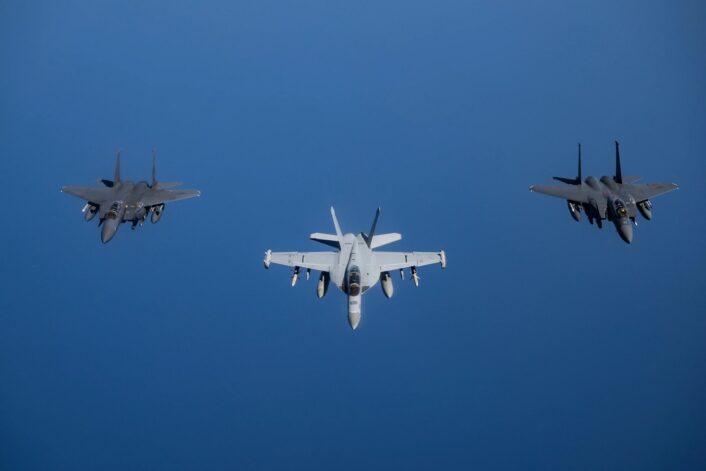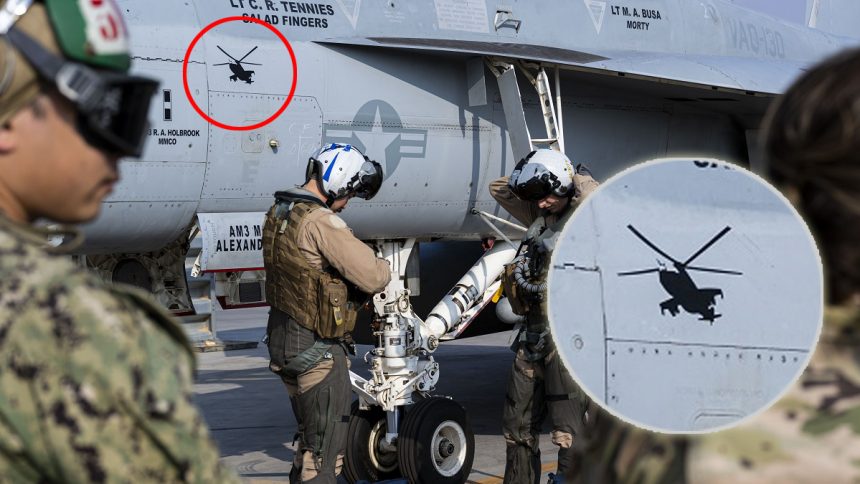The kill mark can be seen in a recent photo of an EA-18G assigned to VAQ-130, currently deployed in the Red Sea aboard the USS Eisenhower aircraft carrier. The Navy, however, has never disclosed any aerial kill of the Growler and the Houthi’s access to Hind helicopters is unconfirmed.
The U.S. Air Force released through AFCENT (United States Air Forces Central) on DVIDS (Defense Visual Information Distribution Service) a photo of a U.S. Navy EA-18G Growler’s crew preparing for a joint mission with F-15E Strike Eagles. The photo might have gone unnoticed if it weren’t for a detail on the aircraft: a kill mark of a Mi-24 Hind attack helicopter on the fuselage.
We don’t know much about the photo, other than it was taken on May 2, 2024 at an undisclosed location in the U.S. Central Command area of responsibility. As it can be seen of the fuselage, the aircraft is assigned to the Electronic Attack Squadron (VAQ) 130 “Zappers”, which is deployed aboard the USS Dwight D. Eisenhower aircraft carrier, although the photo was taken at a land base.
Some more info on this EA-18G growler with the Mi-24 gunship kill mark. The photo above where the mark can clearly be seen was taken on May 2nd. Another photo dated to April 16th from the Ike’s flight deck shows the same aircraft with the mark visible (very dark and blurry). pic.twitter.com/N5KI8rEFpM
— IntelWalrus (@IntelWalrus) May 15, 2024
The USS Eisenhower recently transited the Suez Canal and returned in the Red Sea, after spending some time in the Mediterranean Sea late last month for a port call in Souda Bay, Greece. Given the position of the aircraft carrier and the presence of F-15Es of the 494th Fighter Squadron, it is safe to assume that the photo was taken at Muwaffaq Salti Air Base, Jordan, where the Strike Eagles were based during their deployment.
The origin of the kill mark is completely unknown at this time. Although the Growlers took part in the strike packages during the attacks against Houthi targets, the Navy has never mentioned the presence of a Hind among the targets that were struck. We will look at a series of possibilities for a reasonable origin of the kill mark.
The possible origins of the kill mark
The first, more obvious origin is, obviously, a kill achieved against a Mi-24 helicopter. The Houthis had access to at least one Hind in the past, later destroyed few years ago by the Royal Saudi Air Force, but it’s not clear if there are others operational. Among the confirmed Houthi air assets are a MiG-29 Fulcrum, an F-5 Tiger and multiple Mi-17 helicopters.
Should such origin be confirmed, that would be the first aerial kill achieved by the EA-18G but, given the importance of the event, it would have been surely announced. Also, we don’t know if the Growlers were employed to shoot down drones during the recent months, as only Super Hornets were mentioned among the assets employed in that role by the Navy.
The second option would be an electronic attack against an Mi-24. In 2015 a Growler was applied a kill mark showing a person “hit” by a lightning bolt, which indicated the aircraft targeted a person and jammed or picked up the cell comms.
In a similar way, the kill mark could mean that the EA-18G targeted the Mi-24 to jam it, instead of achieving a hard kill. However, given the absence of lightning bolts in the kill mark, used for Electronic Attack support, and the aforementioned uncertainty about Houthi’s Hinds, we can’t be sure.
The last explanation could be a training kill mark. In fact, a number of Hinds are used to simulate Red Forces during exercises, such as the U.S. Marines’ Weapons Tactics Instructor (WTI) course where the Russian helicopter is a regular presence. Similar training kill marks were also seen on other aircraft, but were usually removed before deployments.










